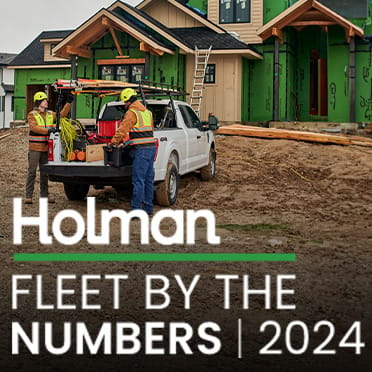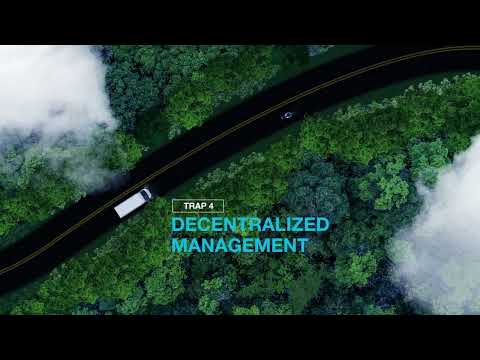- SolutionsWith a strategic solution that works for you and your business, you can unlock revenue-generating opportunities and begin managing your fleet as an investment.Overview
- About UsWhen Holman was founded in 1924, we set something positive in motion. Our consistent focus on people and our commitment to integrity make us who we are today.Overview
 Join Our TeamWe’re not just in the automotive business, we’re in the people business. Join us for the ride.Browse Careers
Join Our TeamWe’re not just in the automotive business, we’re in the people business. Join us for the ride.Browse Careers
Top 5 Municipal Fleet Trends for 2022
Holman Marketing
July 18, 2022

A municipal fleet is critical to the operation of any city or town. If you’re managing a municipal fleet, no doubt you’re feeling the stress of a strained vehicle supply chain and rising vehicle-operating costs. At the same time, the residents you serve want to see you putting their tax dollars to good use. They want to see your team maintaining their neighborhoods in top condition but with tight budget control.
If your public works and emergency vehicles look a little bumped and bruised, that’s ok, as long as they are keeping the streets and public spaces clean and safe. If the vehicles look too shabby, that might reflect badly on the city or town. If they look too flashy and well-equipped, residents might be concerned that excess tax dollars were spent on extraneous accessories.
Keeping the vehicles in your municipal fleet up and running within budget requires coordination of best practices throughout the vehicle lifecycle of Buy, Drive, Service, and Sell. Below are five trends municipal fleets are seeing in 2022 and tips for planning alongside them for long-term costs and efficiencies.
Urgency to Reduce Carbon Emissions
Today, most municipal fleets are working toward vehicle compliance with environmental regulations such as the Energy Policy Act or similar sustainability goals that their local government has established.
When transitioning from gas or diesel to alternative fuel vehicles, including electric and propane, you will find a variety of types for passenger vehicles and light-duty trucks. As you move into medium-duty trucks, the number of options goes down, and even fewer are available for heavy-duty vehicles.
The process of moving to a more sustainable fleet is complicated, from choosing the types of vehicles that are best suited to do the work they need to perform, to navigating the supply chain process, and coordinating an infrastructure plan for charging or refueling.
If you are ready to begin your fleet’s transition or have already started the process and are facing obstacles, you can reach out to organizations such as the Electrification Coalition or automotive solution providers, like Holman. These teams have insight and connections that will help ease the process. They’ll help ensure your greener fleet meets your sustainability goals while also remaining productive.
Securing the Best Lease or Purchase Agreements
With the current vehicle supply chain challenges and economic situation, municipal fleets are facing difficult budgetary decisions. In many cases, municipal fleets are keeping their vehicles in service longer. However, old and worn vehicles experience excessive vehicle downtime. At some point you simply have to replace them or you risk stunted productivity. When you come to that breaking point, should you pay for new vehicles with capital funds? Or should you look for competitive leasing programs?
The GSA AutoChoice is a great resource for municipal fleets to lease or purchase vehicles at volume discounted prices. Also, Holman works with the GSA to provide both fossil fuel-powered vehicles and zero-emission vehicles (ZEVs), including battery electric vehicles (BEV) and plug-in hybrid electric vehicle (PHEV) models.
Optimizing Data Visibility through Telematics
A growing number of municipal fleets are adding telematics devices to their vehicles for a more accurate understanding of vehicle performance and driver behavior. When you integrate your fleet’s telematics data with other licensing, fuel, maintenance, and accident data, you can most effectively identify current efficiencies and savings but also uncover opportunities to introduce additional best practices. Telematics data also helps narrow down options for introducing alternative fuel vehicles – matching minimum vehicle output with maximum work requirements.
Municipal fleet specialists with advanced systems that can integrate all of your vehicle data can help you analyze fleet costs and productivity. For example, the business analysts at Holman, using the Holman Insights system, can help you identify an optimal replacement schedule for vehicles with extended in-service cycles. The data coming from your fleet’s telematics devices will pinpoint vehicles that are contributing least to your municipal operations and pulling the greatest draw on your budget.
Managing In-House Vehicle Maintenance
If your municipal fleet is like most, you also operate your own maintenance garages to control vehicle downtime and operating expenses. In this era when fleet vehicles are staying in service longer, garages may be overwhelmed, since older and high-mileage vehicles have greater repair needs. Plus keeping up with parts inventory is more hectic due to the strained supply chain plus increased demand situation.
In these cases, municipal fleets are relying on maintenance management software such as the Holman Garage Management System. It allows municipal fleets to schedule mechanic workloads with the demand of both preventive and unscheduled maintenance. And it will automate parts inventory replenishing (Holman is a GSA-approved parts supplier), track inspections, integrate accident data and expenses, and help identify vehicles primed for replacement.
Relative to alternative fuel vehicles, this is a time when municipal fleet mechanics need to stay trained on the latest automotive technologies. If your garage is inexperienced in any specific areas, such as electric vehicle maintenance, the Holman Garage Management System is integrated with an expansive network of national account and independent shops. With it, you can coordinate those maintenance needs that need to be outsourced while keeping tight cost control and optimized scheduling.
Maximizing Used Vehicle Sales Results
Another condition resulting from the new vehicle shortage, the used vehicle market is still posting high numbers for most vehicle types. While fuel costs remain above normal, wholesale prices for full-size crossovers and SUVs are going down, but compact cars and subcompact crossovers are increasing in value.
Remarketing success always comes down to finding the right buyer in the right market, and for anyone juggling fleet management with other responsibilities, that’s a hard ask. Municipal fleets that turn over this time-consuming, specialized task to dedicated remarketing professionals will have the best results to report.
Even across the broad range of assets that municipalities typically carry – snowplows, garbage trucks, street sweepers and pavers, excavators, etc. – there are profits to be gained in today’s market. Holman’s EquipmentDirect portal can produce pleasantly unexpected returns that will look great on your books.
Municipal fleet management has its own unique set of challenges and solutions. Finding an automotive services partner that can support you through the entire vehicle supply chain and vehicle life cycle will help ensure you hit your goals and serve your local government well.
To stay up to date with automotive and fleet management news, subscribe to the Morning Brake. And remember, when it comes to municipal fleet management, Holman has the expertise and resources to help you. Contact us today.
Next Post
2022 Lamborghini Aventador SVJ OverviewRelated Resources
Explore more related industry news, insights, and developments.









